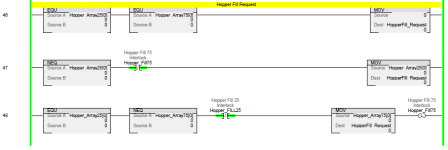The copy instruction in the 75% reset rung will remove the value when it reaches position 0. If Hopper_Array75[0] = hopper number and hopper full, then COP [1] to [0]. This removes the value (basically overwrites the value). I tested that. If hopper 1,2,3,4,5 & 6 enter the 75% array. We fill 1 first. If 4&5 go to 25% before 1 is filled, then 4&5 fills after 1 is filled. Once 4&5 complete, we go back and fill 2,3 &6. You are correct that 4 and 5 are still in the 75% Array. But they are overwritten as they reach position 0 because the hoppers are full. You could also debounce the Fill request if you believe that would be an issue. The Hopper Fill Request tag controls the hopper selection not the array tags.
Which leads one to believe that the same approach would work with an FFU. Don't worry about removing and realigning just unload the full as it reaches 0 until you find one that isn't.
But what do I know. I'm self-taught, and not a doctor.
Which leads one to believe that the same approach would work with an FFU. Don't worry about removing and realigning just unload the full as it reaches 0 until you find one that isn't.
But what do I know. I'm self-taught, and not a doctor.
Last edited:



